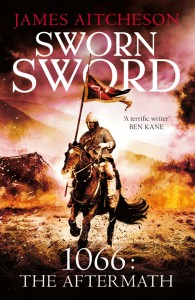The Most Famous Date in British History: An Interview with James Aitcheson
by Sarah Cuthbertson
Sworn Sword is set after the Battle of Hastings, told from a Norman point of view. How would you “sell” it to readers who may not know what happened after 1066?
1066 is the most famous date in British history. While the story of that fateful year is relatively familiar, though, what’s less well known is that Hastings was merely the beginning of a long and bitter war for mastery over England, as the Normans struggled to subdue a hostile country rife with rebellion. Sworn Sword and its sequels tell the story of that turbulent time, when the kingdom’s fate hung in the balance.
What drew you to the period and why did you make your protagonist a Norman knight?
The Norman Conquest is a fascinating subject, since it marks a turning-point not just in the political landscape, but also in the society and culture of Britain. In both scale and speed, the upheaval it generated was unprecedented, and has rarely been matched since.
By taking the viewpoint of Tancred, a Norman knight, I wanted to show the Conquest in a new light and escape the traditional distinction that’s often drawn between the valorous English and the repressive Normans. In reality there was good and evil to be found on both sides of the conflict.
Do you think historical fiction offers a worthwhile perspective on historical events, or is it just for fun?
One of the most powerful things that fiction offers is its ability to put us in other people’s shoes. Not only does it help us see events from alternative points of view, but it can also help to challenge myths and misconceptions about the past.
Which comes first for you – history or story? Do you think it’s OK to take the occasional liberty with the historical record for the sake of the plot?
The advantage of writing fiction set during the Middle Ages is that the historical sources are often fragmentary or conflicting, which allows the novelist plenty of freedom. Part of the joy, for me, comes from weaving my stories in and out of the real events, and so I usually see little reason to alter the facts. When I do, it’s always with good reason, and I own up to it in the afterword at the end of each book.
Have any historical novelists influenced your writing?
I take my influences from many genres, but historical novelists who have particularly inspired me include C.J. Sansom, Barry Unsworth, Bernard Cornwell and Kevin Crossley-Holland. In fact, Crossley-Holland’s evocation of the Welsh Marches in The Seeing Stone was so stirring that it led me to set my second novel, The Splintered Kingdom, in that part of the country as well.
Can you tell us a little about your background?
I’ve always loved writing fiction, but it was only in my final year studying History at Cambridge that I thought about combining that passion with my interest in the Middle Ages. Shortly after graduating I started working on Sworn Sword, and enrolled in the MA in Creative Writing programme at Bath Spa University. A couple of years later the series was picked up by Preface, my UK publisher, and I now write full-time.
A second novel about Tancred, The Splintered Kingdom, is already out in the UK. What’s next for you?
The Splintered Kingdom will be released in the US in August 2014, and the third book in the series, Knights of the Hawk, has just been published in the UK. Set in autumn 1071, it sees Tancred waging war in the Fens, where a group of rebels are making one final, desperate stand against the Normans. I’m currently enjoying getting stuck into research as I decide upon my next project. All will be revealed in due course…
Sworn Sword was published by Sourcebooks in August 2013, and in the UK by Preface in 2011. The author’s website is www.jamesaitcheson.com.
About the contributor: SARAH CUTHBERTSON has been involved in the HNS since 1998 as a reviewer, interviewer and editor. She lives in a Northumberland village which has its very own Roman fort and a quite well-known Wall nearby.
______________________________________________
Published in Historical Novels Review | Issue 66, November 2013







